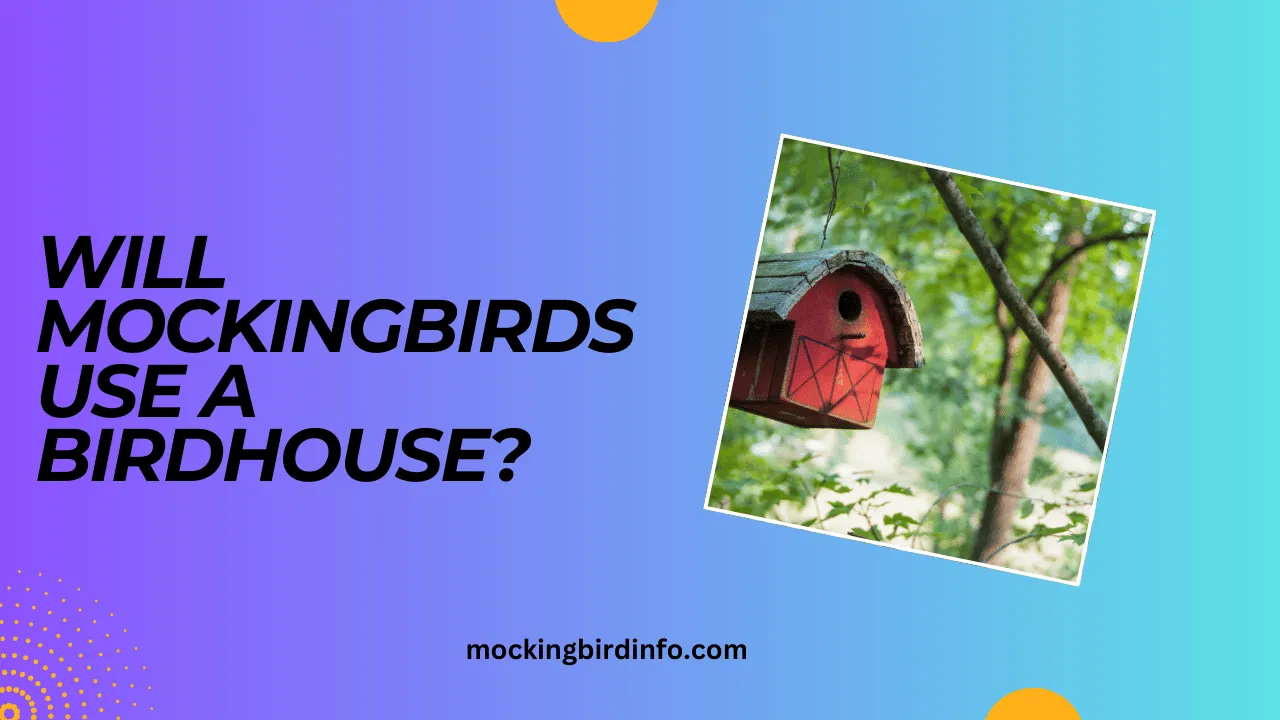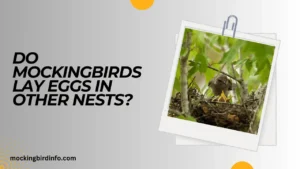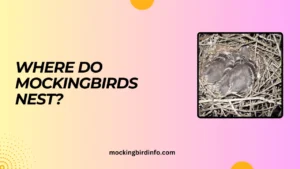Mockingbirds are renowned for their remarkable ability to mimic the songs of other birds, animals, and even mechanical sounds. Their songs are often heard during dawn and dusk, making them one of the most recognizable and beloved birds in many regions.
But as enchanting as their songs are, there’s another aspect of their lives that is just as intriguing: their nesting habits. Traditionally, mockingbirds prefer to build their nests in trees, shrubs, or vines, choosing sites that offer natural protection from predators and the elements.
However, with the increasing urbanization of landscapes and the diminishing availability of natural nesting sites, more and more people are asking: Will mockingbirds use a birdhouse?
The truth is, while mockingbirds are not as inclined to use birdhouses as other species, they may still take advantage of a well-designed one under certain conditions.
In this article, we’ll explore the factors that influence a mockingbird’s decision to nest in a birdhouse, examine the characteristics of a suitable birdhouse, and weigh the pros and cons of providing such shelters.
We’ll also share tips on how to make your yard more inviting for these resourceful songbirds. By the end of this post, you’ll understand how to create the ideal environment for mockingbirds, and how a birdhouse could play a role in supporting their nesting success.
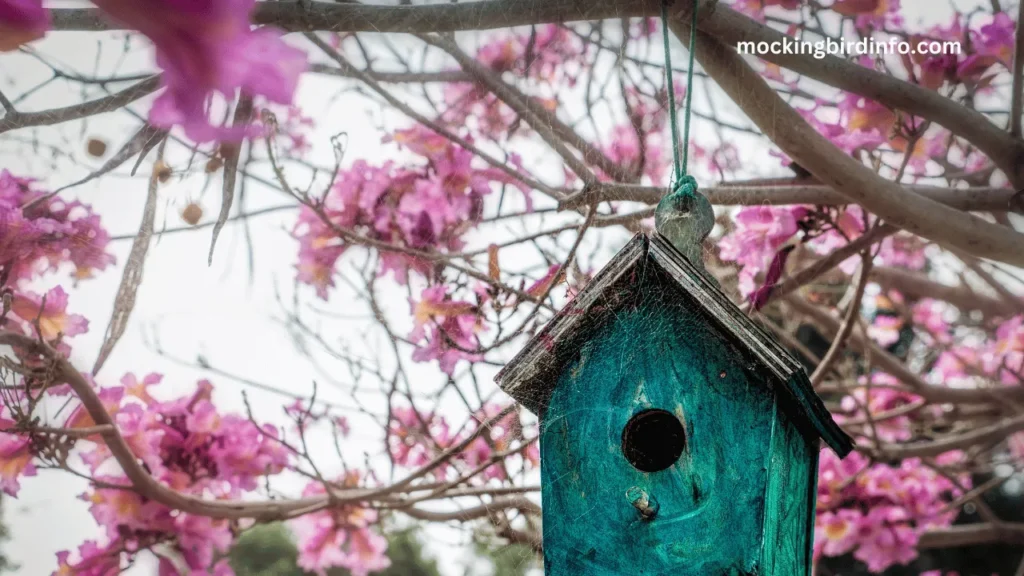
Contents
- 1 Factors Influencing Nest Site Selection
- 2 Characteristics of Suitable Birdhouses
- 3 Benefits and Drawbacks of Birdhouses for Mockingbirds
- 4 Drawbacks
- 5 Conclusion
- 6 FAQs
- 6.1 1. Will mockingbirds always use a birdhouse?
- 6.2 2. What size should a birdhouse for mockingbirds be?
- 6.3 3. Where should I place a mockingbird birdhouse?
- 6.4 4. Can mockingbirds and other birds share a birdhouse?
- 6.5 5. How do I protect a birdhouse from predators?
- 6.6 6. How can I attract mockingbirds to my yard?
Factors Influencing Nest Site Selection
Mockingbirds, like all animals, are driven by instinct and environmental cues when choosing where to build their nests. Several key factors influence their decisions, making it essential to understand these elements if you want to attract mockingbirds to your birdhouse.
Habitat Availability
Mockingbirds thrive in areas with abundant natural vegetation. They often select dense shrubs, small trees, or vines that provide both shelter and a safe environment for raising their young.
When these natural nesting sites are scarce, such as in urban areas or barren landscapes, mockingbirds may be more open to using birdhouses.
Native plantings like berry-producing shrubs or evergreen trees near a birdhouse can mimic the dense cover mockingbirds seek, increasing the likelihood that they’ll use the shelter you’ve provided.
Predation Risk
Predation is a constant threat to mockingbirds and their young. Their instinct is to choose nesting sites that offer maximum protection from predators, such as cats, raccoons, snakes, and other birds of prey.
Birdhouses placed in secure, elevated locations can offer protection against many ground-based predators. To further reduce the risk, place the birdhouse in an area with limited access to climbing predators and away from potential hiding spots that could harbor snakes or other dangers.
This will make the birdhouse more attractive to mockingbirds seeking a safe nesting environment.
Human Disturbance
While mockingbirds are generally adaptable and resilient, excessive human activity near their nesting site can be a deterrent. Constant noise, foot traffic, and disruptions from landscaping or gardening can make mockingbirds wary of nesting in certain areas.
For this reason, it’s crucial to place birdhouses in quiet, low-traffic spots. Selecting a sheltered location that provides both security from predators and privacy from human disturbance is key to attracting mockingbirds to a birdhouse.
Seasonal Considerations
The breeding season for mockingbirds typically occurs in spring through late summer. During this time, they prioritize finding a secure location for raising their young.
A birdhouse with suitable dimensions that provides ample space for laying eggs and shelter for fledglings can be an appealing option when natural nesting sites are unavailable or overcrowded.
The timing of installation is important—placing a birdhouse before the breeding season begins will give mockingbirds time to investigate and possibly move in before they start nesting.
Characteristics of Suitable Birdhouses
Creating a birdhouse that will attract mockingbirds requires attention to several key design elements. These birds are larger than many other common backyard species, so their needs are somewhat different.
Here’s what you should consider when choosing or building a birdhouse for mockingbirds:
Size and Shape
Mockingbirds are medium-sized birds, so their birdhouses need to be spacious enough to accommodate them. An ideal birdhouse for mockingbirds should have internal dimensions of about 6×6 inches, with a height of 8 to 10 inches.
A slightly larger interior will provide enough space for the birds to move freely while still feeling secure. Unlike small songbirds, mockingbirds don’t like to feel cramped in tight quarters.
They also prefer a decently sized entrance to easily fly in and out, as they are larger and more agile than smaller species.
Entry Hole Size
The entry hole is one of the most critical features of any birdhouse. For mockingbirds, an entry hole should measure about 1.5 inches in diameter.
This size is large enough for them to pass through comfortably but small enough to discourage predators like squirrels and larger birds from entering.
A hole that’s too small could deter mockingbirds, while one that’s too large may make the birdhouse vulnerable to threats from other animals.
Material and Construction
The material of the birdhouse plays a vital role in both comfort and durability. Wooden birdhouses are the best option, as they provide insulation and help maintain a stable temperature.
Untreated, natural wood is preferable because it is breathable and provides a natural feel. Avoid using materials like plastic, which can overheat or crack in extreme weather.
For the roof, use a sloped design to prevent rain from pooling inside, and make sure the structure has adequate ventilation to avoid overheating during the hot summer months.
Placement and Positioning
Choosing the right location for your birdhouse is critical. Place it at least 4 to 6 feet above the ground, preferably mounted on a post or tree. Mockingbirds often prefer birdhouses that are not too high but still out of reach of ground predators.
Ensure the birdhouse faces away from prevailing winds and intense afternoon sun to keep the interior temperature comfortable. If possible, position the birdhouse near natural cover like shrubs or small trees—this will make it feel more like a natural nesting site and offer additional protection from predators.
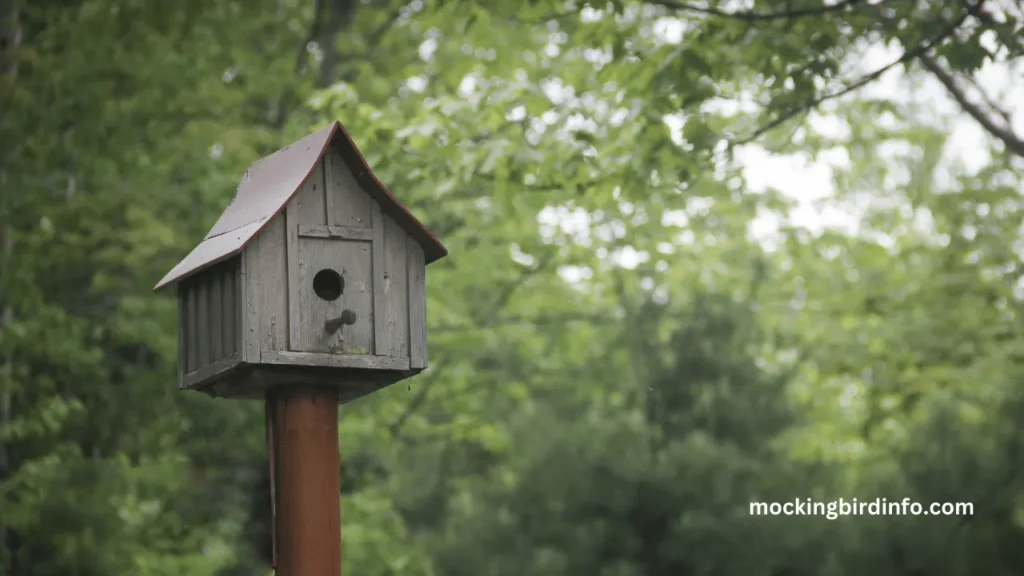
Benefits and Drawbacks of Birdhouses for Mockingbirds
Providing a birdhouse for mockingbirds has its pros and cons. While birdhouses can offer valuable benefits, they may also limit the birds’ natural behaviors and come with some risks. Let’s take a look at the potential benefits and drawbacks:
Benefits
- Protection from Predators: One of the biggest advantages of a birdhouse is the protection it offers from predators. Mockingbirds face numerous threats from animals like cats, raccoons, and snakes, and a birdhouse can act as a safe haven, especially for vulnerable nestlings.
- Weather Shelter: Birdhouses provide shelter from inclement weather, including heavy rain, strong winds, and extreme temperatures. This is especially helpful in areas prone to sudden weather changes that might otherwise disrupt nesting.
- Reduced Parasite Load: Nesting in a birdhouse can reduce the exposure to parasites such as mites and lice, which are more common in natural nesting sites. Regular cleaning of the birdhouse after each nesting season will help minimize these risks.
Drawbacks
- Limited Natural Behavior: Mockingbirds are natural builders, and part of their behavior involves selecting and constructing their own nests. By providing a birdhouse, you may limit their ability to engage in this instinctual activity.
- Disease Transmission: Shared birdhouses can sometimes become breeding grounds for diseases and parasites if not regularly cleaned and disinfected. It’s important to ensure the birdhouse is well-maintained to prevent the spread of illnesses.
- Competition with Other Birds: While mockingbirds may use a birdhouse, so too might other species. This could lead to competition for nesting space, especially if multiple birds claim the same house, creating tension or disputes.
Conclusion
While mockingbirds traditionally prefer natural nesting sites, they may use birdhouses when these options are scarce or unsuitable. The key to attracting these birds lies in offering the right conditions—a secure, predator-free environment, shelter from the elements, and privacy from human disturbances.
By choosing or building a suitable birdhouse, you can provide mockingbirds with a safe space to raise their young, helping to support their populations in urban and suburban areas.
Ultimately, whether you’re a seasoned birdwatcher or a first-time backyard enthusiast, creating a welcoming space for mockingbirds is a rewarding experience.
So, if you’ve been considering adding a birdhouse to your garden, now’s the time to act. Let your yard become a sanctuary for these melodious birds, and watch as they sing their way into your heart.
FAQs
1. Will mockingbirds always use a birdhouse?
Mockingbirds are more likely to use birdhouses in areas where natural nesting sites are limited. However, they tend to prefer natural sites like shrubs and trees when available.
2. What size should a birdhouse for mockingbirds be?
An ideal birdhouse for mockingbirds should have internal dimensions of 6×6 inches with a height of 8-10 inches and a 1.5-inch entry hole.
3. Where should I place a mockingbird birdhouse?
Place the birdhouse 4-6 feet above the ground, ideally near shrubs or small trees, in a quiet, sheltered location away from heavy human activity.
Mockingbirds are territorial and generally do not share birdhouses with other species. They may compete with other birds for nesting space.
5. How do I protect a birdhouse from predators?
Install baffles or predator guards around the pole or tree where the birdhouse is mounted to prevent access from climbing predators like raccoons
6. How can I attract mockingbirds to my yard?
Plant fruiting shrubs and trees, provide water sources, and minimize disturbances to attract mockingbirds.

